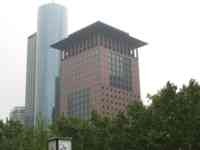
| Path: Eric's Site / Eric / Travel / Germany / Visits / Frankfurt, Gießen, and Heidelberg | Related: Germany, Journal, Visits (Site Map) |
The train was late getting to Mannheim, which worries me. I am going to take the same train on Wednesday and have to change trains in Mannheim to get to Köln. If Wednesday's train is as late getting to Mannheim and the train to Köln is not late, I will miss it, because there are only seven minutes between trains. I looked in Mannheim to confirm that platform 2 (where I get off) is the same piece of concrete as platform 3 (where I get on the next train). If everything works, I will walk in a straight line from Ulm to Köln—Get on from platform 1 in Ulm, walk straight across the train, get off in platform 2 in Mannheim, walk across the platform, get on from platform 3, walk straight across the train, and get off in platform 4 in Köln.
For today's trip, I continued on to Frankfurt and arrived mid-morning.
 |
| A building in Frankfurt. |
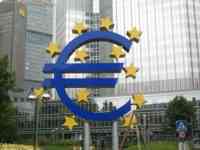 |
| The almighty euro. |
Near the city center, I ducked into the underground tunnels to look for
a bathroom. As in München, there is life below the streets. There are lots
of shops, and also more people walking around there than aboveground.
The tunnels go on for some distance, so it might be possible to get around
parts of the city down there even without taking the trains. The U-Bahn and
S-Bahn are on an even lower level. I think most of the people down there
were workers. Later in the day, after the drizzle
cleared up, I found many tourists walking the pedestrian streets. Workers
belowground and people enjoying life aboveground—wasn't there a
Star Trek episode like that?
 |
| Turm-Palast. |
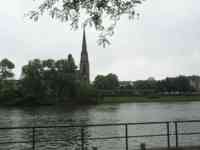 |
| A view from the Main. |
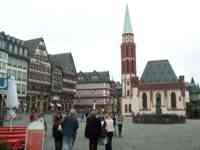 |
| Römerberg. |
Heading north took me past Nutelleria, a café where you can get
Nutella-filled crêpes, Nutella-frosted doughnuts, hot Nutella drink,
Nutella waffles, Nutella fruit wraps, Nutella ice cream, Nutella milk
shakes, Nutella muffins, Nutella cappuccino, Nutella croissants,
Nutella panino, and Nutella fruit nests.
Here are some more pictures taken from the Main.
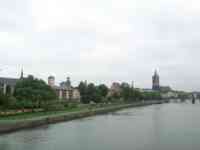 |
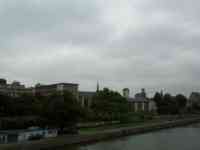 |
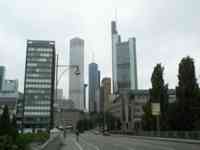 |
| Several views of different parts of Frankfurt from the Main. | ||
As my time left in Frankfurt diminshed, I headed back to the Hauptbahnhof to catch my train to Gießen. I passed the Jewish history museum but did not have time to see it. Some of my future trips may take me through Frankfurt again, in which case I will try to schedule another stop.
At the Hauptbahnhof, I did have a few minutes before my train, so I photographed Straßenbahnen, show below with a few pictures I took earlier in the day.
Note that in addition to the opening and closing steps pictured above, there are two sets of buttons for opening the doors, at different heights to accommodate stops with or without platforms.
Frankfurt has new Straßenbahnen that are similar to but
different from the ones coming to Ulm. I did not ride them in Frankfurt, but
Heidelberg has them too, and I did ride there. They have some snazzy
new features, which I will discuss in the Heidelberg section. For now,
I got on the train to go to Gießen.
 |
| Mathematikum sign. |
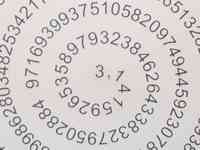 |
| Digits of π on a wall. The missing digit should be easy to spot. |
| Constant-width wheels. |
 |
| Blue straight ramp and brachistochrone. Red tautochrones. |
The red ramps in the image to the right are tautochrones or isochrones,
meaning "same time." The two red ramps are identical and have a special shape.
When two balls are placed on the ramps at different heights and released
at the same time, they reach the bottom at the same time. Even though the
higher ball has farther to go, it accelerates more, because the ramp is
steeper higher up. Using that, the slope is designed so that the time to
reach the bottom is the same from any point.
 |
| Me floating in mid-air. |
(I suspect these ramps are designed for "ideal" point masses sliding without friction, rather than real balls with rotational inertia.)
In another room, you can float in mid-air. So, the museum has exhibits on numbers, geometry, spatial projection, combinatorics, probability, and other mathematical subjects. It is somewhat entertaining, but it is not as informative as I would like a museum to be. There are neat things in mathematics that make you go "Aha!"—the sudden comprehension you get when ideas fit into place and explain something.
I bought a few things in the gift shop and headed out into the city of Gießen. There is not much to see, at least, not that I found. Gießen is not listed in my guidebook. The shopping district is large for the size the city seemed to be, but it has the common stores. There is a lot of public artwork in the shopping district—sculptures, fountains, painted benches, patterns in colored stones in the street.
I went back to the Hauptbahnhof and had dinner at Pasta Mista. Their four-cheese pizza mixed all the cheeses together instead of organizing them in quadrants, and it was a good blend I have not had before. I do not have the words to describe one of the flavors. You will have to go to Gießen and try it. The price of water at Pasta Mista was not bad. I have not mentioned before the price of water and soft drinks in German restaurants. It is high, as much as alcoholic drinks or more. The price varies from place to place, but restaurants may charge you, say, €2 for .25 liters (8.45 ounces) of water.
After dinner, I got on the train to Heidelberg.
As I mentioned before, Heidelberg has new Straßenbahnen. One new feature is a fancy display that shows the upcoming stops in order and moves the names as the stops are passed. Another feature is a solution to the button problem by the door. Older Straßenbahnen have two buttons, one to ask the driver to stop and one to open the doors. It is not always clear to newcomers which button is which, since there may be no labels or worn labels or German labels. Occasionally, a person trying to get off will jab at the wrong button repeatedly in confusion and miss their stop. In the new Straßenbahnen, there is one button. When the Straßenbahn is moving, it asks the driver to stop. When the Straßenbahn is stopped, it opens the doors.
The light switches in Hotel Kranich are on when up. That is the first time I have seen that in Germany.
Frankfurt, Gießen, and Heidelberg make three new cities in one day.
(Well, I have been in Frankfurt before, but only the airport, so it does
not count.)
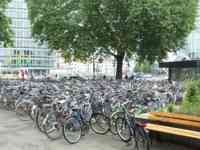 |
| Bicycles outside the Hauptbahnhof. |
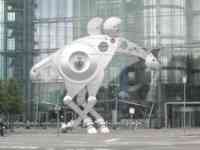 |
| Sculpture across from Hauptbahnhof. |
I found the psychiatric hospital art museum, but it did not open until 11 a.m., so I headed for Heidelberger Schloss (Heidelberg Castle). On the bus to there, two young women were speaking in English about their college classes, and they had US accents, so I introduced myself. They were studying in Heidelberg. Another woman, Ana, joined the conversation. She was touring Germany and was headed to the castle too. As it turned out, she and I had similar plans for the day, so we spent the day together.
Ana and I got off at Rathaus/Bergbahn to go to the castle. We were
disoriented and were not in sight of the castle, so we wandered a block,
asked directions, went back the other way, and started to follow
signs to the castle. Not every intersection had signs, so we guessed
a couple of times. ("Up" is a good hint for getting to a castle on a
hill, but sometimes there were two ups.)
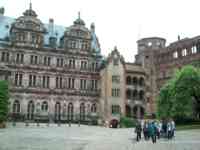 |
| Heidelberg Castle courtyard. |
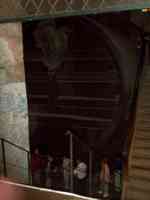 |
| Großes Faß. |
The wine cellar has a large cask for storing wine. It holds 221,726 liters (58,574 gallons). The townspeople paid some of their taxes in wine. There is a dance floor on top of the cask. That is a lot of wine, but alcoholic beverages had an important advantage hundreds of years ago. Alcohol kills some nasty things, and they did not have good means of purifying water, so drinking wine could be better for you than drinking water.
We visited the Museum
of Pharmacy and wandered around inside the courtyard a little.
The pictures below are from the terrace.
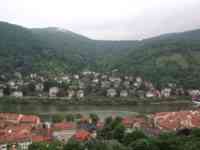 |
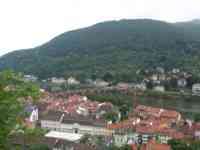 |
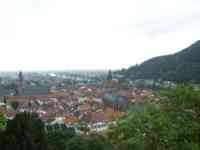 |
| Three views from Heidelberg Castle. | ||
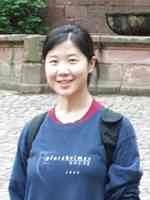 |
| Ana. |
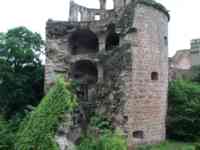 |
| Pulver Turm (Gunpowder Tower), ruined by French forces in 1693. |
It was finally time for the tour, and it was not bad. A few rooms in
the castle have been restored for illustration, but much of the castle
is left ruined. It is a better tourist attraction that way.
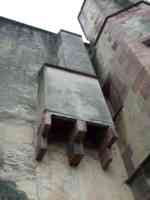 |
| Castle toilets. |
 |
| Remaining wall of destroyed building. |
The lone wall to the right was a building before French forces destroyed it.
After the tour, we went to the funicular (a cable-operated railway on the side of a mountain) and took it down to the Kornmarkt station. We came out of the station to find we were exactly at the Rathaus bus stop. We completely missed the station right in front of us when hunting for the way to the castle. I think we missed the station entrance because it is low and dark.
For the next two or more hours, we explored Haupstraße, which
is mostly a shopping street. At the east end is Heiliggeistkirche,
a Gothic cathedral. We climbed the tower (nothing compared to the
Münster).
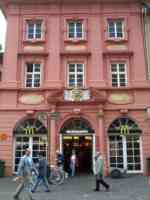 |
| Former royal pharmacy. |
Heidelberg is filled with tourists, especially along Hauptstraße, but it still feels like a community. People are enjoying life there, and the tourists are enjoying the town and not just rushing to see the sights.
English is spoken a lot in Heidelberg. In Ulm, most stores and restaurants have somebody who will speak English if you ask. In Heidelberg, you do not have to ask; they will start speaking English to you as soon as they hear your accent.
Heidelberg University is along Hauptstraße, and we visited its
jail, where bad students were incarcerated. My Lonely Planet
guidebook says they were generally kept a minimum of three days and
fed only bread and water. (By the way, Ana was using the
Let's Go guidebook because she knows the authors.)
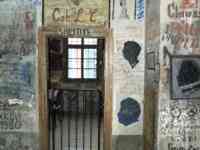 |
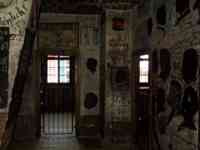 |
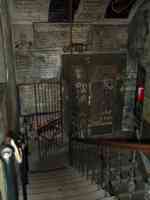 |
| Studentenkarzer (Students Jail). From 1778 to 1914, students were incarcerated here for misdeeds such as drinking, womanizing, and singing. | ||
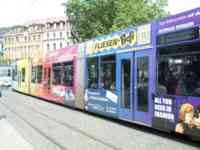 |
| Multicolored Straßenbahn. |
 |
| Self portrait by Anna Frieda Lohse-Wächtler. |
The Prinzhorn Collection of
art created by psychiatric ward patients was on my to-do list but not Ana's,
but she liked the idea, so we went. They had a special exhibit of the work of
Anna Frieda Wächtler. She was born on December 4, 1899, was in a mental
institution or being treated for about the last ten years of her life, and was
killed by the Nazis on July 31, 1940.
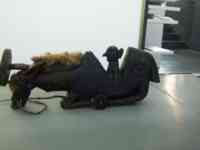 |
| Sculpture by a patient. |
The Prinzhorn Collection completed our tasks in town. The guidebooks
suggest crossing the river to get away from the crowds and see the
view from Philosophenweg. So, we crossed the Neckar river and headed
up.
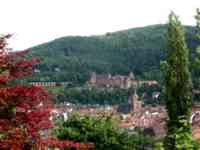 |
| Heidelberg Castle seen from Philosophenweg. |
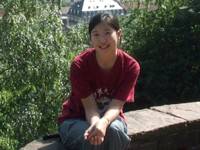 |
| Former stranger. |
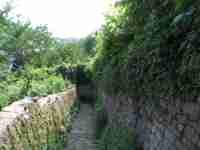 |
| Schlagenweg. |
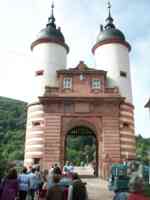 |
| Brückentor. |
I checked a couple of Lonely Planet suggestions for restaurants with vegetarian meals. After looking at the first, I went to Starfish 'n Coffee. It did not have the dish described in the guidebook, but it had some vegetarian crêpes. (Lonely Planet is very good overall, but its restaurant recommendations are not always the best. Of course, it can be hard to find good vegetarian meals.)
I eyed the dinner crêpes but went for Crêpes Austria, with Quarkfüllung, frischen Früchten, Rosinen, Sonnenblumenkernen, und Sahne (curd filling, fresh fruits, raisins, sunflower kernels, and cream). It was good, even without chocolate.
Finally, I headed for the bus stop. While I was waiting, a Brazilian family came up and asked for directions. This makes three foreign cities I have given directions in. I have got to make a button that says, "Directions, €1." They were going to the Hauptbahnhof, so I told them to come with me. However, they had run out of euros and needed to change dollars, so I paid their bus fare and took dollars. We transferred to a Straßenbahn, and, from the Straßenbahn, I saw vegetarian restaurant with a large sign, so that is on my list to try if I get back to Heidelberg.
I caught the train back to Ulm, and the ride was uneventful. I wish I
had more time to add to this page. However, I have to rush off on my next trip.
| Path: Eric's Site / Eric / Travel / Germany / Visits / Frankfurt, Gießen, and Heidelberg | Related: Germany, Journal, Visits (Site Map) |
© Copyright 2003 by Eric Postpischil.